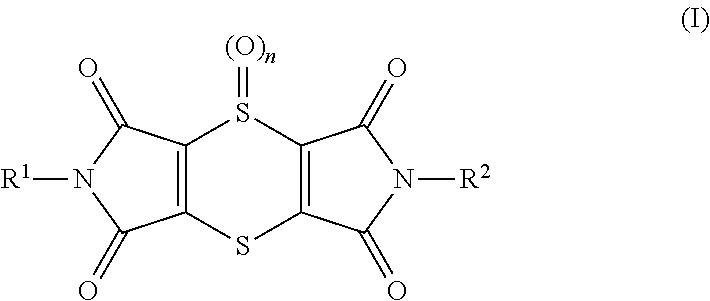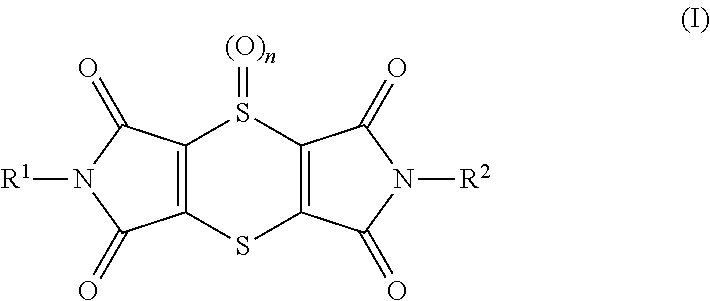Active Compound Combinations
a technology of active compounds and combinations, applied in the field of active compound combinations, can solve the problems of unsatisfactory performance of yeast, slow growth, swelling or gall formation, etc., and achieve the effects of reducing the rate of application of components (a) and (b), reducing the number of phytopathogens, and increasing the range of action
- Summary
- Abstract
- Description
- Claims
- Application Information
AI Technical Summary
Benefits of technology
Problems solved by technology
Method used
Image
Examples
example a
Phytophthora Test (Tomatoes) / Preventive
[0348]Young plants are sprayed with the preparation of (I-1) 2,6-dimethyl-1H,5H-[1,4]dithiino[2,3-c:5,6-c′]dipyrrole-1,3,5,7(2H,6H)-tetrone at the stated rate of application. 4 hours later and after the spray coating has dried on, the plants are sprayed with the aqueous preparation of the biological control agents, e.g. BioNem WP®, at the stated rate of application. The next day the plants are inoculated with an aqueous spore suspension of Phytophthora infestans. The plants are then placed in an incubation cabinet at approximately 20° C. and a relative atmospheric humidity of 100%. The test is evaluated 3 days after the inoculation. 0% means an efficacy which corresponds to that of the untreated control, while an efficacy of 100% means that no disease is observed. The table below clearly shows that the observed activity of the, according to the invention, sequentially applied compounds is greater than the calculated activity, i.e. a synergistic...
example b
Sphaerotheca Test (Cucumbers) / Preventive
[0349]Young plants are sprayed with the preparation of (I-1) 2,6-dimethyl-1H,5H-[1,4]dithiino[2,3-c′]dipyrrole-1,3,5,7(2H,6H)-tetrone at the stated rate of application. 4 hours later and after the spray coating has dried on, the plants are sprayed with the aqueous preparation of the biological control agents, e.g. Serenade® WPO, at the stated rate of application. The next day the plants are inoculated with an aqueous spore suspension of Sphaerotheca fidiginea. The plants are then placed in a greenhouse at approximately 23° C. and a relative atmospheric humidity of approximately 70%. The test is evaluated 7 days after the inoculation. 0% means an efficacy which corresponds to that of the untreated control, while an efficacy of 100% means that no disease is observed. The table below clearly shows that the observed activity of the, according to the invention, sequentially applied compounds is greater than the calculated activity, i.e. a synergist...
example c
Venturia Test (Apples) / Preventive
[0350]Young plants are sprayed with the preparation of (I-1) 2,6-dimethyl-1H,5H-[1,4]dithiino[2,3-c′]dipyrrole-1,3,5,7(2H,6H)-tetrone at the stated rate of application. 4 hours later and after the spray coating has dried on, the plants are sprayed with the aqueous preparation of the biological control agents, e.g. Serenade® WPO, at the stated rate of application. The next day the plants are inoculated with an aqueous conidia suspension of the causal agent of apple scab (Venturia inaequalis) and then remain for 1 day in an incubation cabinet at approximately 20° C. and a relative atmospheric humidity of 100%. The plants are then placed in a greenhouse at approximately 21° C. and a relative atmospheric humidity of approximately 90%. The test is evaluated 10 days after the inoculation. 0% means an efficacy which corresponds to that of the untreated control, while an efficacy of 100% means that no disease is observed. The table below clearly shows that t...
PUM
| Property | Measurement | Unit |
|---|---|---|
| time | aaaaa | aaaaa |
| time | aaaaa | aaaaa |
| time | aaaaa | aaaaa |
Abstract
Description
Claims
Application Information
 Login to View More
Login to View More - R&D
- Intellectual Property
- Life Sciences
- Materials
- Tech Scout
- Unparalleled Data Quality
- Higher Quality Content
- 60% Fewer Hallucinations
Browse by: Latest US Patents, China's latest patents, Technical Efficacy Thesaurus, Application Domain, Technology Topic, Popular Technical Reports.
© 2025 PatSnap. All rights reserved.Legal|Privacy policy|Modern Slavery Act Transparency Statement|Sitemap|About US| Contact US: help@patsnap.com



